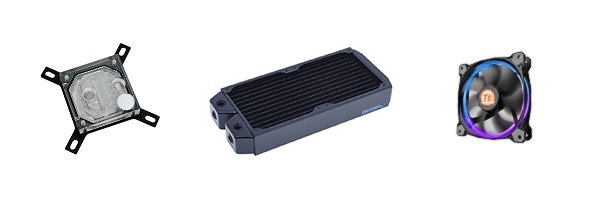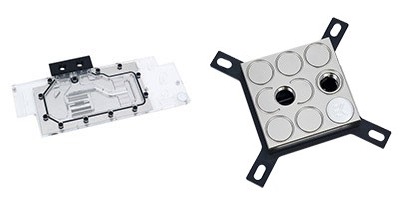Breadcrumbs
Liquid Cooling - Water Blocks, Radiators, and Fans
Understanding key components of your liquid cooling system.
Water Blocks, Radiators, and Fans are three components of a liquid cooling loop that work together to transfer the heat away from its source. Below we look at what role each of these components plays in your system.

Water Blocks:
Whether they cover a large area with several heat sources like might be found on a complex video card, or they are smaller to cover a specific area like the surface of a CPU, the job of a water block is to be the vehicle to make contact with the heat source as the first step of transferring that heat away. Liquid coolant picks up the heat from the water block and moves it along through the next steps in the cooling loop. The water block, generally, will be sized according to the component that it is being directly attached to.

Radiators
Like Water Blocks, Radiators also come in varying sizes and specifications. Radiators in a liquid cooling loop work much like radiators in a car, just on a much smaller scale. Radiators serve as a point in the system where air can flow through the radiator and cause the heat to dissipate from the system. Radiator thickness is a measurement that differentiates radiators, and typically refers to the thickness of the outer framework of the radiator. Radiator housing will usually have threads for screws that are used to mount fans on their surface, and the actual fin part of a radiator is slightly less thick than the framework to allow for this type of mounting. This space also allows for airflow over the fins of the radiator which aids in heat dissipation. Finally, radiator density refers to the number of fins per inch (FPI) on the surface of a radiator. Another important factor to consider when selecting a radiator will be how and where it is going to fit within your computer case.

What does all of this mean so far? A couple of additional factors are important with water blocks and radiators. Generally, more surface area translates into a capability to carry more heat away faster, and, specifically with radiators, more thickness and more fin density also translates into a capability to dissipate more heat – but with one catch: When radiators become thicker or fin density is higher, the radiators need the help of cooling fans in order to do their job to the best of their ability.
Fans:
Cooling fans have long been a key component to reduce heat and increase airflow in computer systems. Just because it is called liquid cooling does not mean that fans are never necessary in the process though. Radiators are designed in various sizes to accommodate the attachment of common size cooling fans being attached to the surface of the radiators. Terms like single or double are used to designate how many standard size fans a radiator was designed to accommodate.
Many common fans designed for use in computer cases will work fine in a water cooling system, but to help decide which one is best for your system consider two key factors – static pressure and air flow. Static pressure relates to how well a fan can overcome impediments, for example: higher fin density, thicker radiators, or foreign obstructions as simple as a little dusty build up on the fins. Air flow refers to how much air the fan can move under ideal conditions in a defined time period. Depending on the surface area, thickness, and fin density of your radiator, as well as any potential obstructions within your case, you will want a sufficient capability of static pressure and air flow to efficiently cool your system without going overboard unnecessarily.
Other factors to consider with fans include fan shape and design (matching the shape of your radiator to cover the most surface is best), fan blade design (some curved or cupped fan blades can provide higher efficiencies), and fan noise (generally, you want your system to be as close to silent as possible, with only enough fan noise to get the job done). Finally, fans that take advantage of PWM (typically 4-pin connectors) allow for more customized management of fan features.

Summary:
- Water Blocks are on the front line – they collect the heat to be transferred away from the heat source
- Radiators are the point in the system where the heat is dissipated from the cooling loop
- Fans are typically used to help the radiator to do its job efficiently and effectively
This article is part of a multi part series.
Liquid Cooling - Tubing and Fittings can be found here.
Liquid Cooling - Coolants Reservoirs and Pumps can be found here.
Liquid Cooling - Process and Terms can be found here.
Technical Support Community
Free technical support is available for your desktops, laptops, printers, software usage and more, via our new community forum, where our tech support staff, or the Micro Center Community will be happy to answer your questions online.
Forums
Ask questions and get answers from our technical support team or our community.
PC Builds
Help in Choosing Parts
Troubleshooting
